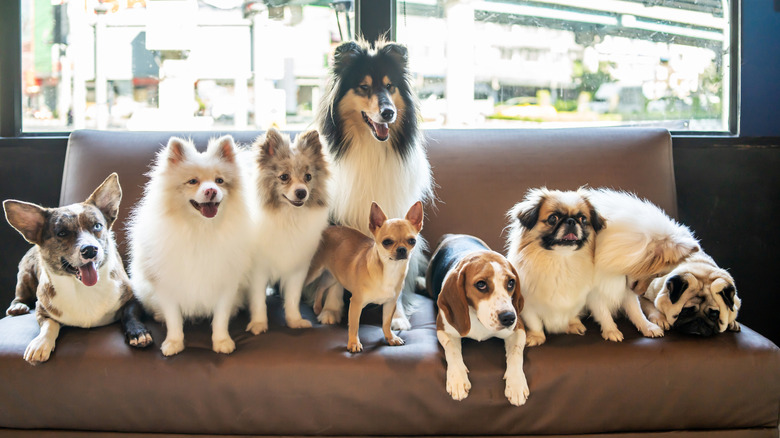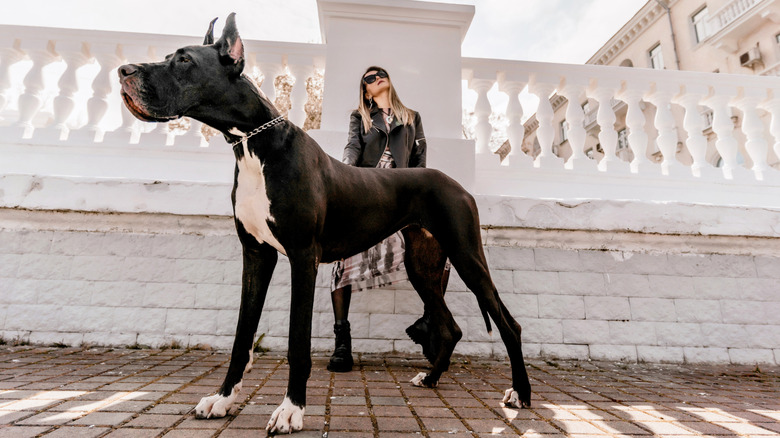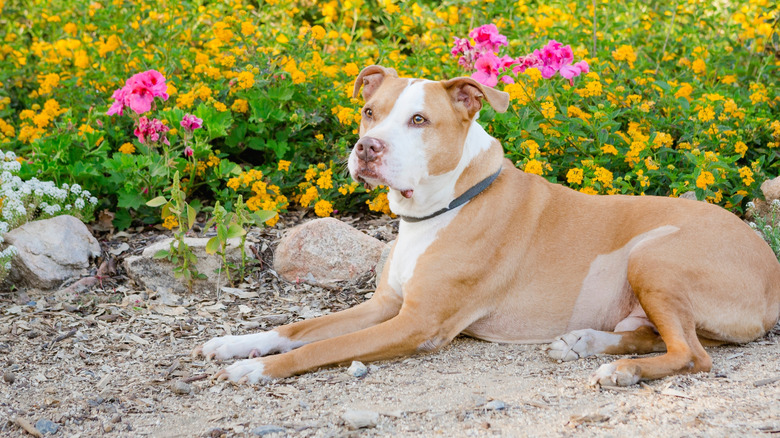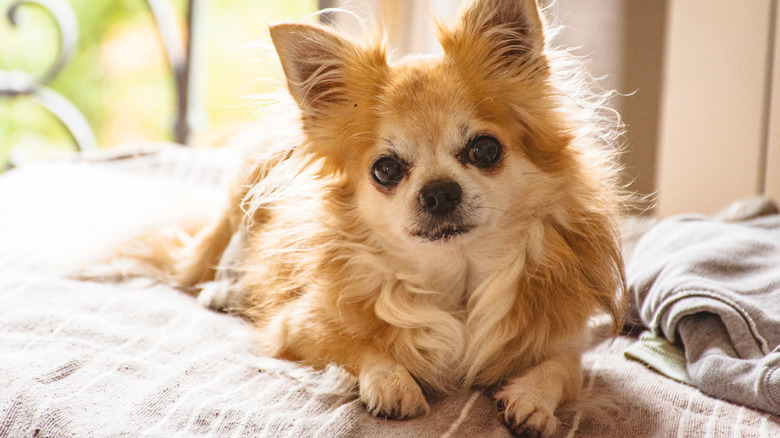5 Dog Breeds That Don't Do Well In Apartments
We may receive a commission on purchases made from links.
Apartment living can be advantageous for some reasons, but if you're a dog owner, it presents some disadvantages in the form of extra policies and added fees. Most property management companies have certain pet restrictions for apartment complexes, but even if a certain breed isn't on the "restricted" list, it can still present inconveniences for tenants and management. There are large, medium, and small breeds that have a tendency to not do well in apartments, including the Great Dane, American pit bull terrier, Chihuahua, border collie, and Jack Russell terrier.
Some dogs exceed the weight limit or are considered "too aggressive" and are, therefore, not allowed to live in certain apartment complexes, with the support of breed-specific legislation. Others might be naturally more inclined to bark a lot. If you're planning to adopt a dog and you live or plan to live in an apartment, knowing which breeds might not do well in apartments can help you make more informed decisions.
It's also important to note that if your dog's breed is on the list below, you might be able to take extra steps to convert your pup into the ideal roommate. These include paying for extra training, getting pet insurance, and providing sufficient exercise and stimulation opportunities.
Great Dane
Great Danes are among the largest dog breeds and weigh more than many adults do. When fully grown, females can reach 110-140 pounds while males can max out at 140-175 pounds. Some apartment complexes list specific breeds that are not permitted in their units, while some have weight limits, allowing only dogs under a certain size — others have both. So if you don't see Great Danes on the list of restricted breeds, chances are, your dog still won't be allowed because of their weight.
Due to their incredibly large size, Great Danes are strong, powerful dogs. This means they might be difficult to control on a leash, especially if other dogs are around, which could lead to an inadvertent injury. Apartment property management companies typically don't want to take this risk by allowing this breed in their units, and that's why they restrict it.
On the other hand, even if extra-large breeds are allowed at your apartment complex, and you've been considering adopting a Great Dane, it's important to consider your living space. A Great Dane obviously takes up a lot of horizontal space when walking around, so will you and the dog, plus their crate, bed, and toys, have enough space in your apartment? If the answer is no, you may want to consider another breed or a more spacious place to live.
American pit bull terrier
If breed restrictions didn't exist, many American pit bull terriers would be allowed in apartments, since some weigh only 30 pounds. The unfortunate truth, however, is that pit bulls are commonly banned by rental properties, even though no scientific evidence indicates that this breed is more dangerous than any other. Your dog might be the sweetest one in the entire neighborhood, but many people fear pit bulls because they were initially bred for fighting, among other reasons.
It's also important to note that some pit bulls don't do well in apartments because they're not socialized or trained, or they lack sufficient mental stimulation. However, if yours is trained and socialized, they can make a great apartment roommate. Just be sure to provide enough exercise opportunities, such as daily walks. Pit bulls have pros and cons, just like any other breed, but if you put forth the effort, you can end up with many more pros, including in an apartment.
If you've had a pit bull for a few years but the complex you're considering doesn't allow the breed, the manager might make an exception under certain circumstances. Nobody knows your pitty better than you do, so if they're well-trained, well-behaved, and friendly, prove it. Try to appeal the restrictions by requesting an in-person pet interview with the landlord, submitting videos, and creating an online profile of your dog. Make your canine companion likable to strangers. You may also want to apply for and show proof of liability pet insurance.
Chihuahua
They're small and adorable, they make great lap dogs, and they're allowed at pretty much every pet-friendly apartment complex. However, the Chihuahua still may not be the best breed for apartment living because they have a tendency to bark a lot. You may have heard these dogs referred to as "yappers" or "yappy dogs" because they seem to always have a lot to say. Apartment walls are thin, so a Chihuahua's incessant barking may eventually disturb the neighbors, especially if the barking repeatedly wakes them up.
Is every Chihuahua a "yapper"? No. Can you train a dog to bark less? Sure can! Whether you're already a Chihuahua parent or have fallen in love with one to adopt, there are ways you can share an apartment with one without bothering the neighbors. Consider options like training your dog to stop barking at the door, so that every tenant passing by to their own apartments doesn't cause a commotion.
Border collie
The border collie is considered one of the most intelligent dog breeds, but this means they require ample mental stimulation and exercise, which can come in the form of walks and playtime. Without it, they may exhibit destructive behaviors that might end up costing you your security deposit when you move out. This is why some pet experts list this breed as one that doesn't do well in apartments.
Keep in mind that border collies are herding dogs, so they enjoy chasing things. They're also inherently active and enjoy long walks. In fact, some pet organizations recommend that they receive at least two hours of daily exercise. This might be challenging or impossible for apartment dwellers unless they work from home or are otherwise with their border collies for several hours each day.
To keep your border collie mentally stimulated in an apartment, be sure to provide them with plenty of toy options. Have a few designed for chewing and a few designed for foraging. Puzzle toys and snuffle mats, like Awoof's Snuffle Mat for Dogs, are both great options for the latter.
Jack Russell terrier
If Tigger were a dog, he would probably be a Jack Russell terrier. It doesn't take much to activate the zoomies for this dog breed. With their high-energy personalities, they love to run around and seem to always be in a happy, playful mood. They're also very fast with the ability to sprint up to 38 miles an hour, so having a spacious yard is a great way for them to release some energy and have some fun. However, since apartment properties don't offer spacious yards, renting a unit with a Jack Russell terrier may not be the best option.
Jack Russell terriers can get the zoomies pretty much anywhere, including a 500-square-foot living space. To compensate for the lack of floor space, some might run up, down, and across a sofa the way you'd expect a cat to move. You may have witnessed this with your own terrier if you're currently renting. To give your pup running opportunities that don't involve furniture, see if there's a spacious fenced-in dog park nearby, or consider purchasing a human running or walking pad, like Orinar's Walking Pad, for them.





